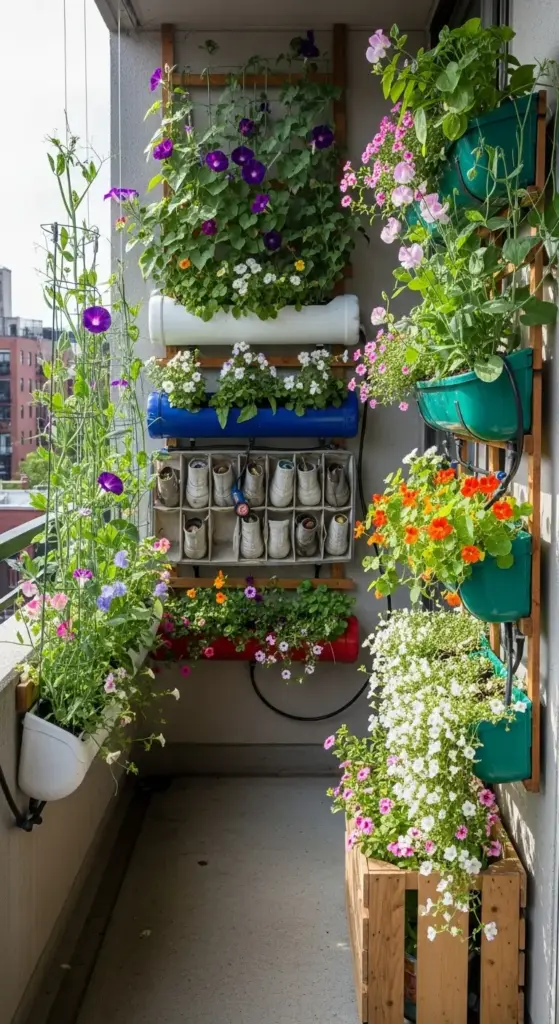4. Vertical Flower Walls: Maximizing Small Space Impact

My tiny Brooklyn balcony was basically a concrete box with delusions of grandeur. Eight feet by four feet of pure urban disappointment.
That’s when I discovered vertical gardening – and suddenly my sad little space became the envy of every neighbor with a “real” yard.
Small Space, Big Dreams
Urban apartment gardening forces you to think creatively or give up entirely. I chose creativity (after a brief pity party).
My first vertical flower wall was a disaster made from chicken wire and hope. It collapsed during the first rainstorm, taking my poor petunias with it.
The breakthrough came when I realized space-saving solutions need to be engineered, not just pretty. Wall-mounted planters require proper support and drainage – who knew?
I started with pocket planters made from recycled plastic bottles. Cheap, lightweight, and surprisingly effective for small yard solutions.
Tiered plant stands doubled my growing space without taking up more floor area. Vertical thinking literally changed everything about my gardening possibilities.
DIY Magic with Everyday Materials
DIY vertical structures became my weekend obsession once I figured out the basics.
My favorite craft supply hack? Shoe organizers make incredible vertical planters. The clear plastic pockets are perfect for herbs and trailing flowers.
I built my best vertical garden structure using PVC pipes, pool noodles for insulation, and basic hardware store brackets. Total cost: under $50 for a 6-foot growing wall.
Pallet gardens are Instagram-famous for good reason. Sand them down, add landscape fabric backing, and you’ve got instant vertical growing space.
The key is starting small and building up. My first successful wall was just three hanging planters arranged at different heights.
Repurposed materials work beautifully – old gutters, wooden crates, even large tin cans create unique vertical displays with character.
Climbing Stars and Trailing Beauties
Climbing flowers transformed my boring fence into a living masterpiece.
Morning glories are absolute speed demons – they’ll cover a vertical structure in one season. Just be warned, they’re basically the golden retrievers of the plant world – enthusiastic and everywhere.
Sweet peas provide incredible fragrance and delicate colors perfect for vertical displays. They prefer cooler weather, making them ideal for spring and fall rotations.
For trailing flowers, bacopa and calibrachoa create stunning cascading effects. These trailing varieties spill beautifully from wall-mounted containers.
Nasturtiums are my go-to edible climbers – gorgeous flowers you can actually eat in salads. They handle neglect like champions.
Black-eyed Susan vine blooms non-stop in vertical gardens. The bright orange flowers pop against green foliage walls.
Watering Without Drowning Everything
Irrigation systems for vertical gardens stumped me for months. Gravity is not your friend when water runs straight down and out.
Drip irrigation saved my sanity and my plants. I installed a simple timer system that delivers water slowly to each level.
My DIY solution uses soaker hoses threaded through the vertical structure. Cheap, effective, and way less complicated than fancy systems.
Self-watering planters work brilliantly for wall-mounted gardens. The water reservoir prevents both overwatering and drought stress.
The secret is watering from the top and letting it cascade down. I learned to position plants by water needs – thirsty ones at the top, drought-tolerant ones below.
Mulching vertical gardens prevents rapid moisture loss. I use lightweight coconut coir that won’t add too much weight to the structure.
Style Integration That Actually Works
Outdoor home decor and vertical gardens should complement each other, not compete.
I painted my DIY structures to match my patio furniture. Color coordination makes everything look intentional instead of cobbled together.
Lighting integration turns vertical flower walls into stunning evening focal points. I strung LED lights through the structure for magical nighttime ambiance.
Modern vertical gardens work beautifully with geometric planters and architectural plants. Think clean lines and repeated patterns.
For bohemian outdoor spaces, I love macrame plant hangers at varying heights. The texture adds visual interest even when plants aren’t blooming.
Seasonal decorations keep vertical displays interesting year-round. I swap out summer flowers for fall mums, then winter evergreen arrangements.
Maintenance Reality Check
Seasonal maintenance for vertical gardens is different from traditional beds – and honestly, easier in some ways.
Plant rotation strategies keep displays looking fresh. I swap out annual flowers every season while keeping perennial climbers as the backbone.
Spring setup involves checking irrigation systems, refreshing potting soil, and installing new climbing supports.
Summer maintenance is mostly deadheading and monitoring water needs. Vertical gardens dry out faster than ground-level beds.
Fall preparation means harvesting seeds, taking cuttings, and protecting tender perennials from winter damage.
Winter care in cold climates requires moving container plants to protected areas or wrapping vertical structures for insulation.
The best part? Vertical gardening puts everything at eye level, making maintenance tasks way easier on your back.
Ready to bring the garden indoors with fresh-cut blooms? Our next section reveals the secrets of creating a cut flower garden that provides gorgeous arrangements all season long. Learn which flowers give you the biggest bang for your buck and how to make your homegrown bouquets last twice as long!









GIPHY App Key not set. Please check settings